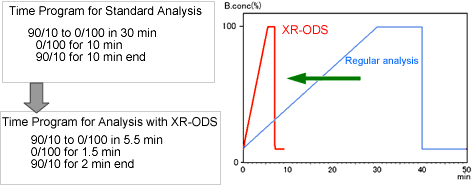Q: I am thinking of using a column shorter than the one I am currently using. Can I continue using the same gradient program without changing it?
A:
Basically, if you are going to use the same mobile phase composition, then it is not necessary to reconsider the time program. The necessary calculations can be made simply from the ratio of column capacities and the ratio of mobile phase flow rates. In cases where the form of separation changes due to differences in retention characteristics between standard analysis columns and high-speed analysis columns such as the Shim-pack XR-ODS, the mixing ratio must be adjusted as necessary. The following formula can be used to make the simple calculation required to create a time program for ultrafast analysis.
TF = TC x (VF/VC) / (uF/uC)
TF: Time with Shim-pack XR-ODS
TC: Time with standard analysis column
VF: Capacity of Shim-pack XR-ODS
VC: Capacity of standard analysis column
uF: Mobile phase flow rate with Shim-pack XR-ODS
uC: Mobile phase flow rate with standard analysis column
For example, when switching from a flow rate of 1.0 mL/min with a standard analysis column (length: 150 mm; inner diameter: 4.6 mm) to a flow rate of 1.2 mL/min with a Shim-pack XR-ODS column (length: 75 mm; inner diameter: 3.0 mm), the time program for the concentration gradient will be as follows.

Using the Method Transfer Program (contact your Shimadzu sales representative for details) allows the time program for analysis with a high-speed analysis column to be calculated automatically.


